story and photos by Kayte Deioma
Some people think that by definition a museum should have grand paintings or ancient statues and take all day to visit. Museums of everyday history like historic homes and local history museums are more likely to present more mundane items of common use over a period of time in a particular place. Archaeological museums may have grand discoveries like artifacts from ancient Egypt or Angkor Wat. In fact, many people go into archaeology with a romantic notion of going off and discovering mythical civilizations a la Indiana Jones. In reality a lot of the field work is digging around in the refuse of a bygone era. However, in looking at what people chose to discard or build over, even close to home, sometimes researchers do uncover a lost city.
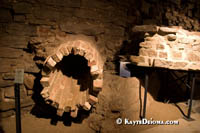 That’s what happened when the Society for Development of the Old Port had archaeologists survey the Pointe-ŕ-Calličre in Old Montreal with the intention of creating a park across from the Old Customs House. What they found were remnants of previous occupants of the site all the way back to the city’s founding in 1642. Stone walls of generations of earlier buildings had been built over the first Catholic cemetery where French settlers and Indians were buried side by side.
That’s what happened when the Society for Development of the Old Port had archaeologists survey the Pointe-ŕ-Calličre in Old Montreal with the intention of creating a park across from the Old Customs House. What they found were remnants of previous occupants of the site all the way back to the city’s founding in 1642. Stone walls of generations of earlier buildings had been built over the first Catholic cemetery where French settlers and Indians were buried side by side.
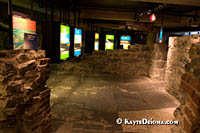 The archaeological site was deemed too important to be covered with a park. The challenge was how to preserve the site from deterioration, yet make it accessible to the public. The solution was the Pointe-ŕ-Calličre, Montréal Museum of Archaeology and History, also known as PAC. The museum was created by re-building Place Royal, the city’s first public square, and the new Éperon building overtop of the underground site in such a way that visitors could explore the excavation below. The underground passages extend under the Old Customs House, which was incorporated into the museum.
The archaeological site was deemed too important to be covered with a park. The challenge was how to preserve the site from deterioration, yet make it accessible to the public. The solution was the Pointe-ŕ-Calličre, Montréal Museum of Archaeology and History, also known as PAC. The museum was created by re-building Place Royal, the city’s first public square, and the new Éperon building overtop of the underground site in such a way that visitors could explore the excavation below. The underground passages extend under the Old Customs House, which was incorporated into the museum.
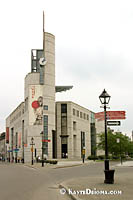 Pointe-ŕ-Calličre is the point formed by the joining of the Little St. Pierre River and the St. Lawrence River when the original French settlement of Ville Marie was established at this spot on the Island of Montreal. It was named for Louis-Hector de Calličre, third Governor of Montreal, who built his home here. The Little St. Pierre was later turned into a covered sewer system and then disappeared altogether. Although the little river is no more, the contemporary gray masonry façade and clock tower of the Éperon building conform to the shape of the point and the buildings that existed previously on this site. The entrance to the underground complex is through this modern structure.
Pointe-ŕ-Calličre is the point formed by the joining of the Little St. Pierre River and the St. Lawrence River when the original French settlement of Ville Marie was established at this spot on the Island of Montreal. It was named for Louis-Hector de Calličre, third Governor of Montreal, who built his home here. The Little St. Pierre was later turned into a covered sewer system and then disappeared altogether. Although the little river is no more, the contemporary gray masonry façade and clock tower of the Éperon building conform to the shape of the point and the buildings that existed previously on this site. The entrance to the underground complex is through this modern structure.
In the multimedia theatre, a 20-minute video introduction in French with English translation via headsets is projected onto translucent screens suspended into the ruins below. A brief history of Montreal and Point-a-Calliere is narrated by Montreal’s founder, missionary Paul Chomedey de Maisonneuve, who leads you through the centuries.
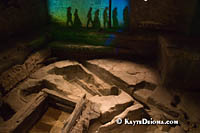 The primary exhibit at Pointe-ŕ-Calličre is the archaeological site itself, where you can see how an outhouse was situated above the graves in the first Catholic cemetery and wander among the stone walls to see how buildings were built on top of previous structures. You can walk where the Little St. Pierre River was channeled into the sewage canal with protruding brick conduits and you can see remains of Governor Calličre’s home.
The primary exhibit at Pointe-ŕ-Calličre is the archaeological site itself, where you can see how an outhouse was situated above the graves in the first Catholic cemetery and wander among the stone walls to see how buildings were built on top of previous structures. You can walk where the Little St. Pierre River was channeled into the sewage canal with protruding brick conduits and you can see remains of Governor Calličre’s home.
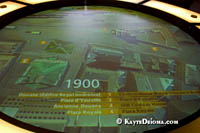 In addition to the excavated ruins, the artifacts found in the dig are displayed and interpreted according to the appropriate time period from Indian arrowheads to an 18 th century chamber pot and a 20 th century milk bottle. Multicolored information displays provide the history and significance of the times and the artifacts. A large interactive circular display lets you see the layout of the area in whatever time period you select. Glass windows in the floor show models of the neighborhood through the ages. At the far end toward the Customs House, motion-activated historic characters emerge
In addition to the excavated ruins, the artifacts found in the dig are displayed and interpreted according to the appropriate time period from Indian arrowheads to an 18 th century chamber pot and a 20 th century milk bottle. Multicolored information displays provide the history and significance of the times and the artifacts. A large interactive circular display lets you see the layout of the area in whatever time period you select. Glass windows in the floor show models of the neighborhood through the ages. At the far end toward the Customs House, motion-activated historic characters emerge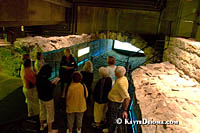 holographically from the stone walls to tell their story.
holographically from the stone walls to tell their story.
A semi-permanent exhibit, Montreal Love Stories, is on display in the Old Customs House. It is a celebration of Montreal’s multicultural couples and family traditions. The upper galleries in the Éperon building host a variety of traveling exhibits. There is also an excellent restaurant, L’Arrivage, upstairs in the Éperon. It is only open for lunch and reservations are recommended since it is very popular with local business people. The museum Gift Shop is around the corner at 150 St. Paul West.
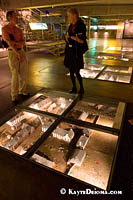 Free guided tours are available in English on Saturdays at 2:30 pm all year long with additional tours at the same time on Tuesdays, Thursdays and Sundays in the summer. French tours are at 1:30 pm on the same days.
Free guided tours are available in English on Saturdays at 2:30 pm all year long with additional tours at the same time on Tuesdays, Thursdays and Sundays in the summer. French tours are at 1:30 pm on the same days.
Pointe-ŕ-Calličre, Montréal Museum of Archaeology and History
350 Place Royale, Corner of de la Commune
Old Montréal, Quebec
H2Y 3Y5 Canada
Tel.: (514) 872-9150
E-mail: info@pacmusee.qc.ca
Website: www.pacmusee.qc.ca
Metro: Place-d’Armes station
Parking: pay parking in the Old Port.

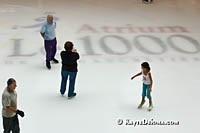 The Atrium Le 1000 was not on my list of potential rainy day activities when I set out for Montreal. I didn’t see it listed in any of the guidebooks or webs sites I used for my research. But once in Montreal, it was the one spot everyone mentioned when I talked about fun things to do on a rainy day, so I had to check it out for myself. There are plenty of ice skating rinks in this city where kids learn to skate almost as soon as they learn to walk, but only one in a downtown office block.
The Atrium Le 1000 was not on my list of potential rainy day activities when I set out for Montreal. I didn’t see it listed in any of the guidebooks or webs sites I used for my research. But once in Montreal, it was the one spot everyone mentioned when I talked about fun things to do on a rainy day, so I had to check it out for myself. There are plenty of ice skating rinks in this city where kids learn to skate almost as soon as they learn to walk, but only one in a downtown office block.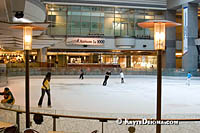 This year-round ice rink is located in Le 1000, a 51 story office building at 1000 de La Gauchetiére Street West, the tallest structure in Montreal. Le 1000 has garnered awards for being environmentally responsible and for the design of the food court surrounding the Atrium Le 1000 skating rink. Of the ring of restaurants, only the Subway sandwich shop was open on a Sunday afternoon, but there was a steady flow of people coming and going on the ice.
This year-round ice rink is located in Le 1000, a 51 story office building at 1000 de La Gauchetiére Street West, the tallest structure in Montreal. Le 1000 has garnered awards for being environmentally responsible and for the design of the food court surrounding the Atrium Le 1000 skating rink. Of the ring of restaurants, only the Subway sandwich shop was open on a Sunday afternoon, but there was a steady flow of people coming and going on the ice.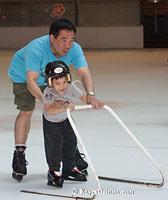 There are several things about the Atrium Le 1000 that make it a great place for children and beginners to take to the ice. According to staff, the ice itself is softer than at most skating rinks. Since the air isn’t any colder than cool air conditioning, that’s easy to believe. They also provide the Easy Skater, a frame like a walker that you can hold onto while your feet learn how to control the blades. This is such a brilliant idea. For klutzes like me, the idea of skating is intimidating because I’ve seen how easy your feet can slip out from under you if you don’t know what you’re doing. Having a sturdy frame to support you as you cross the ice for the first time is a confidence builder. Easy Skaters come in child and adult sizes.
There are several things about the Atrium Le 1000 that make it a great place for children and beginners to take to the ice. According to staff, the ice itself is softer than at most skating rinks. Since the air isn’t any colder than cool air conditioning, that’s easy to believe. They also provide the Easy Skater, a frame like a walker that you can hold onto while your feet learn how to control the blades. This is such a brilliant idea. For klutzes like me, the idea of skating is intimidating because I’ve seen how easy your feet can slip out from under you if you don’t know what you’re doing. Having a sturdy frame to support you as you cross the ice for the first time is a confidence builder. Easy Skaters come in child and adult sizes.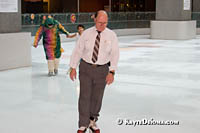 The diversity of the crowd was refreshing, from families with children of all ages to well-seasoned seniors. There were regulars and first-timers, off-season hockey players keeping blade muscles in shape and a bus driver in uniform gliding through his lunch hour for a bit of exercise. A couple young girls were getting some impromptu lessons from a senior coach who was there for an afternoon spin around the ice.
The diversity of the crowd was refreshing, from families with children of all ages to well-seasoned seniors. There were regulars and first-timers, off-season hockey players keeping blade muscles in shape and a bus driver in uniform gliding through his lunch hour for a bit of exercise. A couple young girls were getting some impromptu lessons from a senior coach who was there for an afternoon spin around the ice.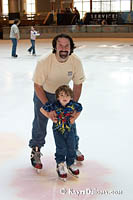
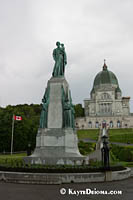 Montreal is a great city for exploring on your own and any of the venues in this issue would be perfectly appropriate to visit alone. But I somehow think of spiritual places as good solo destinations to take a quiet moment and ponder the universe. St. Joseph’s Oratory on Mount Royal is a nice spot for such pondering.
Montreal is a great city for exploring on your own and any of the venues in this issue would be perfectly appropriate to visit alone. But I somehow think of spiritual places as good solo destinations to take a quiet moment and ponder the universe. St. Joseph’s Oratory on Mount Royal is a nice spot for such pondering.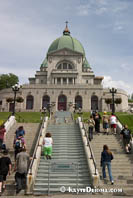 St. Joseph’s Oratory, at 856 feet (263 meters) above sea level, is the highest point in Montreal. From street level to the top of the dome is 506 feet (155 meters). That’s a lot of stairs to climb, especially if you are a pilgrim climbing the stairs on your knees. If you don’t feel like scaling the 233 steps up to the Crypt level, a shuttle will drive you from the gate house at street level up to the entrance.
St. Joseph’s Oratory, at 856 feet (263 meters) above sea level, is the highest point in Montreal. From street level to the top of the dome is 506 feet (155 meters). That’s a lot of stairs to climb, especially if you are a pilgrim climbing the stairs on your knees. If you don’t feel like scaling the 233 steps up to the Crypt level, a shuttle will drive you from the gate house at street level up to the entrance.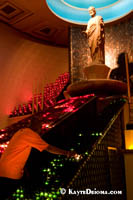 The Arrow Guide suggests entering the building from the side entrance into the Votive Chapel (marked with the number 1), a long corridor lined with votive altars. Each one is a tribute to St. Joseph in his various functions as model for workers, guardian of virgins, support of families, terror of demons, consolation of the afflicted, hope of the sick, patron of the dying, and protector of the Church. Halfway down the hall in the center lamp rack, 3,500 of the chapel’s 10,000 votive candles rise up to a statue of Joseph with arms outstretched. Between the altars, wooden crutches of those healed by Brother André are displayed hanging in rows. Notably, there are no aluminum crutches or other evidence of people being healed since the pious man’s passing.
The Arrow Guide suggests entering the building from the side entrance into the Votive Chapel (marked with the number 1), a long corridor lined with votive altars. Each one is a tribute to St. Joseph in his various functions as model for workers, guardian of virgins, support of families, terror of demons, consolation of the afflicted, hope of the sick, patron of the dying, and protector of the Church. Halfway down the hall in the center lamp rack, 3,500 of the chapel’s 10,000 votive candles rise up to a statue of Joseph with arms outstretched. Between the altars, wooden crutches of those healed by Brother André are displayed hanging in rows. Notably, there are no aluminum crutches or other evidence of people being healed since the pious man’s passing. To the left is the Crypt Church, so named for the flattened arches supporting the ceiling and its position at the foot of the Basilica. Rather than the traditional cross over the altar, a nine-foot statue of St. Joseph takes pride of place. The Christ statue on the large crucifix to the right of the altar has worn feet from the hands of many pilgrims. A giant statue of Brother André looms in front of the stained glass windows on the right wall. The colorful panels represent events in the life of St. Joseph.
To the left is the Crypt Church, so named for the flattened arches supporting the ceiling and its position at the foot of the Basilica. Rather than the traditional cross over the altar, a nine-foot statue of St. Joseph takes pride of place. The Christ statue on the large crucifix to the right of the altar has worn feet from the hands of many pilgrims. A giant statue of Brother André looms in front of the stained glass windows on the right wall. The colorful panels represent events in the life of St. Joseph.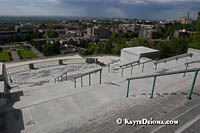 Doors at the back of the Crypt Church will take you to the escalators up to the Concourse Hall where you will find access to the terrace which provides a view of Montreal down the west side of Mount Royal. You’ll also find restrooms and drinking fountains on this floor and the stairway to theBrother André Display. You have to take the stairs, as the escalator bypasses this area. This exhibit contains recreations of the doorkeeper’s lodge at Notre Dame College, Brother André’s office and the hospital room where he died, some of them with original features. However the most important artifact in this display is the reliquary with Brother André’s heart.
Doors at the back of the Crypt Church will take you to the escalators up to the Concourse Hall where you will find access to the terrace which provides a view of Montreal down the west side of Mount Royal. You’ll also find restrooms and drinking fountains on this floor and the stairway to theBrother André Display. You have to take the stairs, as the escalator bypasses this area. This exhibit contains recreations of the doorkeeper’s lodge at Notre Dame College, Brother André’s office and the hospital room where he died, some of them with original features. However the most important artifact in this display is the reliquary with Brother André’s heart.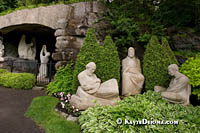 Back down on the Concourse level you can exit to the Way of the Crossand the Oratory Gardens. The larger-than-life Stations of the Cross lead through the gardens to the Pool and Fountain of Redemption. It’s a beautiful place to dwell and contemplate in nice weather, but if it’s raining significantly, you might want to proceed up the escalator to the OratoryMuseum.
Back down on the Concourse level you can exit to the Way of the Crossand the Oratory Gardens. The larger-than-life Stations of the Cross lead through the gardens to the Pool and Fountain of Redemption. It’s a beautiful place to dwell and contemplate in nice weather, but if it’s raining significantly, you might want to proceed up the escalator to the OratoryMuseum.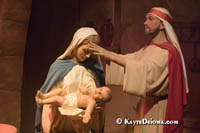 The front galleries are used for rotating exhibits from the Museum’s significant collection of artwork related to the Holy Family, St. Joseph and Brother André. Part of every year includes a Nativity Exhibit with 200 to 300 of the Museum’s thousands of crčches from around the world from the 6 th century through the present. Each annual exhibit includes at least 100 nativity scenes that have not been exhibited before. They range from miniatures to life size, from Indian needlework to Vietnamese Mother of Pearl, Sudanese ebony and incense paste from Singapore. The permanent exhibit at the back of the Museum is a series of wax figures behind glass portraying scenes from the life of St. Joseph.
The front galleries are used for rotating exhibits from the Museum’s significant collection of artwork related to the Holy Family, St. Joseph and Brother André. Part of every year includes a Nativity Exhibit with 200 to 300 of the Museum’s thousands of crčches from around the world from the 6 th century through the present. Each annual exhibit includes at least 100 nativity scenes that have not been exhibited before. They range from miniatures to life size, from Indian needlework to Vietnamese Mother of Pearl, Sudanese ebony and incense paste from Singapore. The permanent exhibit at the back of the Museum is a series of wax figures behind glass portraying scenes from the life of St. Joseph.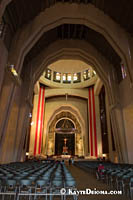 Above the museum is the Basilica. You can go back outside at this level to admire the 60 foot Corinthian columns close up and enjoy the view. This is the highest point you can climb if you’re ascending the 283 stars up the front of the Oratory. The interior dome rises 195 feet (60 m) above the floor. The cavernous space holds 2200 people seated in the metal folding chairs or 10,000 standing. It is rather stark in contrast to many basilicas in the world and less inviting than the cozy Crypt below. The dome is the third largest in the world after St. Peter’s in Rome and an African tribute to St. Peter’s, the Basilica of Our Lady of Peace in Ivory Coast. The stained glass windows depict some of the miraculous events in Canadian history attributed to the intervention of St. Joseph. The Grand Organ at the back of the Basilica has 5,811 pipes, with the longest 32 feet (9.75 m) tall. Organ recitals are every Sunday at 3:30 all year with a series of guest performances on Wednesday evenings in the summer.
Above the museum is the Basilica. You can go back outside at this level to admire the 60 foot Corinthian columns close up and enjoy the view. This is the highest point you can climb if you’re ascending the 283 stars up the front of the Oratory. The interior dome rises 195 feet (60 m) above the floor. The cavernous space holds 2200 people seated in the metal folding chairs or 10,000 standing. It is rather stark in contrast to many basilicas in the world and less inviting than the cozy Crypt below. The dome is the third largest in the world after St. Peter’s in Rome and an African tribute to St. Peter’s, the Basilica of Our Lady of Peace in Ivory Coast. The stained glass windows depict some of the miraculous events in Canadian history attributed to the intervention of St. Joseph. The Grand Organ at the back of the Basilica has 5,811 pipes, with the longest 32 feet (9.75 m) tall. Organ recitals are every Sunday at 3:30 all year with a series of guest performances on Wednesday evenings in the summer.